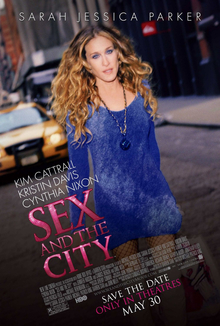 This week my wife dragged me to see Sex and the City (King, 2008). I don't have much to say about the movie itself. But I do want to comment on a recurring criticism of the movie. Many reviews complained that it is "too long". But the movie is only 148 minutes. That's just under 2 1/2 hours. Titanic was 3 1/4 hours! In fact, according to my calculations, the average length of the top 25 grossing American movies of all time is 142 minutes -- only six minutes shorter than Sex and the City.
This week my wife dragged me to see Sex and the City (King, 2008). I don't have much to say about the movie itself. But I do want to comment on a recurring criticism of the movie. Many reviews complained that it is "too long". But the movie is only 148 minutes. That's just under 2 1/2 hours. Titanic was 3 1/4 hours! In fact, according to my calculations, the average length of the top 25 grossing American movies of all time is 142 minutes -- only six minutes shorter than Sex and the City.So when people complain about the movie being long, I think they mean it feels long. As Einstein taught us, time is relative. The average length of the top 25 grossing Bollywood movies is 164 minutes long (2 hours and 44 minutes). Clearly there is a cultural difference here. But I don't think it has anything to do with Indian vs. American attention spans. I think it has to do with our expectations of narrative structure.
When I saw Sex and the City, I actually thought the movie wasn't quite long enough. As a viewer of the TV series, I thought poor Charlotte's storyline about getting pregnant didn't get full screen time the way the other three women's storylines did. Charlotte had some great scenes in Carrie's storyline about marrying Big. But on TV, there would have been more truly Charlotte-centric scenes. At 2 1/2 hours the movie is only the length of 5 episodes of the TV show. That's not a long movie, it's a short TV season. In short, I'm arguing that the movie felt long to people because its narrative was structured like a multi-episode arc of a TV series rather than a typical Hollywood movie.
In film school Hollywood screenwriters are taught to build their scripts around a three-act structure (a device which I believe was developed by Syd Field in the 1970s, though some people mistakenly try to trace it to Aristotle's Poetics.). Sometimes (for example in the work of screenwriting teacher Chrisopher Vogler) this three-act structure is combined with features of Joseph Cambell's structuralist-inspired theory of mythology. Here I am suggesting (pace Cambell) that the problem with any of these theories is that they are culturally relative. But because Hollywood has structred movie narratives this way for so long, mainstream audiences have come to expect these structural rhythms. Movies that violate this pattern -- such as Bollywood movies, art movies, and Sex and the City -- feel too long, too slow, or otherwise wrong to audiences used to Hollywood three-act structure.
I think that's why Bollywood movies feel so long to me. I was actually surprised when I added it up and found that the average length is less than three hours. My standard comment to the uninitiated is that most Bollywood movies are, like, four hours long. But thinking in terms of a three-act structure helps me see why I thought this. What I was feeling was that Indian movies are twice as long as American movies when in fact they are less than one and a half times as long. This is because many Bollywood movies are structured around two sub-stories. There is a beginning, middle, and end -- and then another beginning, middle, and end. For example the film may start with be a romance story that culminates in a wedding halfway through the film. But whereas a Hollywood movie would stop here, Bollywod filmmakers start up a new plot. Maybe there is a baby born, or the hero's father dies, or the heroine's brother strikes up a new romance with the hero's sister. In short, it feels to American audiences that the film has been attached to its sequel.
So what's the lesson of all this? I suppose a Hollywood studio executive could draw the conclusion that movies ought never deviate from the standard structure or audiences won't understand it. I would rather draw the conclusion that it is possible to learn alternative structures. I encourage my screenwriter friends to experiment with teaching us new ways of storytelling -- as I believe most young filmmakers are already doing. Finally, I would like to conclude that, because TV is structured around episodes, its structure is more flexible. You can have a one episode story-arc, or a three episode arc, or a one season arc, or an arc that lasts the entire series. The best shows have all these layers of narrative going on at the same time. Thus TV is amenable to a wider variety of story structures, TV is often a better medium for narrative than film is.
In conclusion: Movies are about spectacle, but if you want to tell a story, then use television. Of course, TV still has some growing to do as an artform. But with the history of TV during the last two decades -- from Seinfeld (1989-98) and Twin Peaks (1990-1) to Buffy the Vampire Slayer (1997-2003) and The West Wing (1999-2006) on to cable shows like Six Feet Under (2001-2005) and Weeds (2005-2008) just to name a few of my own favorites -- we are well on our way to a truly golden age of TV.


No comments:
Post a Comment